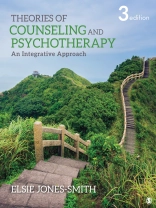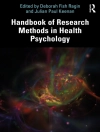A step forward from the traditional textbook on counseling theories,
Theories of Counseling and Psychotherapy: An Integrative Approach offers students a comprehensive overview of past and current approaches to psychotherapy and counseling, with a modern approach to theories of psychotherapy. An extensive array of mainstream theories, as well as contemporary approaches such as narrative, feminist, LGBT, and post-modern, are covered. Author Elsie Jones-Smith helps readers to construct their integrated approach to psychotherapy by learning how to develop a broad range of therapeutic expertise to meet the needs of a culturally diverse clientele. In addition to listing and describing theories, this text compares and contrasts them to show their strengths and weaknesses. The
Third Edition includes a new chapter on trauma-informed counseling/psychotherapy and provides updated references, sections, and studies reflecting the latest developments within the helping professions.
Included with this title:
The password-protected Instructor Resource Site (formally known as SAGE Edge) offers access to all text-specific resources, including a test bank and editable, chapter-specific Power Point® slides. <
Jadual kandungan
Preface
Acknowledgments
About the Author
Chapter 1. Introduction: Journey Toward Theory Integration
Brief Overview
The Role of Theories of Psychotherapy
Integrative Psychotherapy: The Focus of This Book
Professional and Personal Issues for the Journey Toward Psychotherapy or Counseling Integration
Therapist Beliefs and Values: Relationship to Choosing a Theory
Ethical Issues in Starting Your Journey Toward Developing an Integrative Counseling Theory
Summary
PART I: THE FIRST FORCE IN PSYCHOTHERAPY: PSYCHOANALYSIS AND PSYCHODYNAMIC THEORIES
Psychology’s Indebtedness to Sigmund Freud
Some Distinctions Between Psychoanalysis and Psychodynamic Theories
Integration of Freudian Concepts: The Unconscious and Transference
New Forms of Psychoanalysis
Chapter 2. Psychoanalytic and Psychodynamic Theories
Brief Overview
Psychoanalytic Therapy
Key Concepts of Sigmund Freud
The Therapeutic Process
The Movement Toward Contemporary Psychodynamic Therapy
Ego Psychology
Object Relations Theory
Self Psychology
Comparison and Contrast of Psychoanalytic and Psychodynamic Theories
Other Theorists and Therapy Approaches Considered Psychoanalytic
Brief Psychodynamic Therapy
Key Concepts of Carl Jung
Research and Evaluation of Psychoanalytic and Psychodynamic Approaches
Summary
Chapter 3. Adlerian Psychotherapy
Brief Overview
Major Contributor: Alfred Adler (1870–1937)
Key Concepts
The Therapeutic Process
Research and Evaluation
Summary
PART II: THE SECOND FORCE IN PSYCHOTHERAPY: BEHAVIOR THERAPY AND COGNITIVE THERAPY
Definition of Behavior Therapy
The Three Waves of Behavior Therapy
Chapter 4. Behavior Therapy and Integrated Psychopharmacology
Brief Overview
Behavior Therapy
Key Concepts of Behavior Therapy
The Therapeutic Process
Current Trends in Behavior Therapy
Applied Behavioral Analysis
Behavioral Activation: A Promising Treatment for Depression
The Behavior Activation Model and Treatment for Depression
Behavior Activation Techniques
Integrated Psychopharmacology
Research and Evaluation
Summary
Chapter 5. Cognitive Approaches to Psychotherapy
Brief Overview
Rational Emotive Behavior Therapy
Key Concepts of REBT
The Therapeutic Process and REBT
Social Modeling, Observational Learning, and Self-Efficacy
Cognitive Therapy and Depression
Key Concepts of Beck’s Cognitive Therapy
The Therapeutic Process
Cognitive Neuroscience
The Third Wave in Behavior Therapy: Mindfulness Integrated Into Cognitive Behavioral Therapies (DBT, ACT, and MBCT)
Differences Between ACT, CBT, DBT, and MBCT
Research and Evaluation of CBTs
Summary
Chapter 6. Reality/Choice Therapy
Brief Overview
Major Contributor: William Glasser (1925–2013)
Key Concepts
The Therapeutic Process
Research and Evaluation
Summary
PART III: THE THIRD FORCE IN PSYCHOTHERAPY: EXISTENTIAL AND HUMANISTIC THEORIES
The Existential and Humanistic Theories
The Existential Worldview
The Humanistic Worldview
Merger of Existentialism and Humanism
New Developments in Humanism: Motivational Interviewing, the Stages of Change Theory, Interpersonal Psychotherapy, and Emotion-Focused Therapy
Challenges Facing the Existential–Humanistic School
Chapter 7. Existential Therapy
Brief Overview
Major Contributor: Rollo May (1904–1994): The First Major American Existentialist
Key Concepts of Existential Therapy
The Therapeutic Process
Major Contributor: Viktor Frankl (1905–1997) and Logotherapy
Research and Evaluation
Summary
Chapter 8. Person-Centered Therapy and Interpersonal Psychotherapy
Brief Overview
Major Contributor: Carl Rogers (1902–1987)
Key Concepts
The Therapeutic Process
Research and Evaluation
Summary
Chapter 9. Gestalt Therapy and Emotion- Focused Therapy: Two Experiential Therapies
Brief Overview
Major Contributor: Fritz Perls (1893–1970)
Philosophical Roots for Gestalt Therapy
Influence of Existentialism on Gestalt Therapy
Key Concepts
The Therapeutic Process
Research and Evaluation
Emotion-Focused Therapy
Goals of EFT
Summary
Chapter 10. Motivational Interviewing and the Stages of Change Theory
Brief Overview
Motivational Interviewing
Key Concepts of MI
The Therapeutic Process
Research and Evaluation of MI
The Transtheoretical Model of Change or the Stages of Change Theory
Key Concepts of the Transtheoretical Model of Change
The Therapeutic Process
Research and Evaluation of TTM
Summary
Chapter 11. The Expressive Arts and Counseling
Brief Overview
Expressive Arts: A Human Tradition
Key Concepts
Three Expressive Arts Therapeutic Approaches
Art Therapy and Neuroscience
Research and Evaluation
Summary
PART IV: THE FOURTH FORCE IN PSYCHOTHERAPY: SOCIAL CONSTRUCTIVISM AND POSTMODERNISM
Postmodernism and the Road to Social Constructivism
Differences Between Modern and Postmodern or Constructivist Psychotherapies
The Postmodern Psychotherapies
Outline of Chapters in Part IV
Chapter 12. Multicultural Counseling: Theories and Practice
Brief Overview
Brief History and Overview of the Multicultural Movement
New 2017 APA Multicultural Guidelines
What Is Multicultural Counseling?
Multicultural Counseling: Two Emerging Theories
The Therapeutic Process
Beginning the Cultural Competence Journey
The Culturally Competent Skill of Counselor Cultural Humility
Major Barriers to Culturally Competent Counseling or Therapy
Racial or Ethnic, Gender, and Sexual Orientation Bias: Major Barriers to Cultural Competence
Research and Evaluation
Summary
Chapter 13. Transcultural and International Approaches to Counseling and Psychotherapy: Bridges to Asia, Africa, Europe, and the Middle East
Brief Overview
Commonalities Among Asian Theories of Personality and Psychotherapy
Japanese Approaches to Psychotherapy
Chinese Contributions to Psychotherapy: Mindfulness
Hindu Indian Approaches to Counseling and Psychotherapy
African Approaches to Healing and Psychotherapy: Nigeria
Arab Approaches to Psychotherapy
Research and Evaluation of Transcultural Psychotherapy
Summary
Chapter 14. Feminist Therapy and LGBTQ Therapy
Feminist Therapy
Key Concepts of Feminist Therapy
The Therapeutic Process in Feminist Therapy
Research and Evaluation in Feminist Therapy
Gay and Lesbian Therapy
Key Concepts of LGBTQ Therapy
The Therapeutic Process in Gay and Lesbian Psychotherapy
Summary
Chapter 15. Integrating Spiritual and Religious Issues During Psychotherapy
Brief Overview
Key Concepts in Spiritual and Religious Counseling
Research and Evaluation
Summary
Chapter 16. Solution-Focused Therapy
Brief Overview
Major Contributors: Insoo Kim Berg and Steve de Shazer
Key Concepts
The Therapeutic Process
Research and Evaluation
Summary
Chapter 17. Narrative Therapy
Brief Overview
Key Concepts
The Therapeutic Process
Research and Evaluation
Summary
Chapter 18. Strengths-Based Therapy
Introduction
Major Contributor: Elsie Jones-Smith
Key Concepts
The Neurobiology of Human Strengths Development
Strengths-Based Therapy and Mindsets
The Revised Strengths-Based Counseling Model
Strengths-Based Therapy: Overview of Phases
Strengths-Based Therapy Techniques
Summary
Chapter 19. Family Therapy Approaches
Introduction
Multigenerational Family Therapy
Key Concepts of Multigenerational Family Therapy
The Therapeutic Process
Case Illustration From a Bowenian Family Therapy Approach
Experiential Family Therapy
Key Concepts of Experiential Family Therapy
Case Illustration of the Experiential Approach to Family Therapy
Structural Family Therapy
Key Concepts of Structural Family Therapy
The Therapeutic Process
Case Illustration of Structural Family Therapy
Strategic Family Therapy
Key Concepts of Strategic Family Therapy
The Therapeutic Process
Research and Evaluation
Summary
PART V: THE FIFTH FORCE IN PSYCHOTHERAPY: NEUROSCIENCE AND THEORIES OF PSYCHOTHERAPY
Introduction
The Promise of Neuroscience
Criteria for Neuroscience to Be the Fifth Force in Psychotherapy
Chapter 20. Neuroscience, Interpersonal Neurobiology, and Trauma-Informed Counseling
Introduction
Major Contributors
Toward a Theoretical Framework for Neuropsychotherapy
Key Concepts of Neuroscience
The Therapeutic Process
Recent Brain-Based Therapies: Interpersonal Neurobiology, Neurocounseling, Trauma-Informed Counseling, and Coherence Therapy
Neuroscience and the DSM–5
Research and Evaluation
Summary
Chapter 21. Integrative Psychotherapy: Constructing Your Own Integrative Approach to Therapy
Introduction
Pathways to Psychotherapy Integration
Toward Developing Your Own Approach to Integrative Psychotherapy
Points of Psychotherapy Integration: Therapist Worldviews, Goals, Role of Therapist and Client, and Counseling Techniques
Worldviews of Theories of Psychotherapy
Key Concepts of Theories of Psychotherapy
The Therapeutic Process
Top Five Ways to Determine Your Theoretical Orientation to Psychotherapy
Summary
References
Index
Mengenai Pengarang
Dr. Elsie Jones-Smith is a licensed psychologist, a certified school psychologist, and the President of the Strengths-Based Institute. She holds two Ph.D. degrees, one in clinical psychology from Michigan State University and the other in counselor education from the University at Buffalo. She is a Fellow in two divisions of the American Psychological Association, Division 17, the Society of Counseling Psychology, and Division 45, the Society for the Psychological Study of Culture, Ethnicity, and Race. She is a Diplomate in counseling psychology (ABPP), a Fellow of the Academy of Counseling Psychology, and a prior Distinguished Visitor for the American Psychological Association.Dr. Jones-Smith has extensive experience in strengths-based therapy, graduate level teaching, program evaluation (Head Start, Title –Chapter 1), tests construction, and psychological consultation with schools. Her clinical orientation is strengths-based. She has currently expanded her clinical work to include cultural neuroscience.She is the author of six books, including the recently published Culturally Diverse Counseling: Theories and Practice (Sage, 2019). Second Edition of Theories of Counseling and Psychotherapy: An Integrative Approach (2016) with Sage Publications (which presents a chapter on Neuroscience and describes it as the Fifth Force in psychology); Spotlighting the Strengths of Every Single Student: Why U.S. Schools Need a New, Strengths-Based Approach (2011, ABC-CLIO (2011); and Nurturing Nonviolent Children: A Guide for Parents, Educators, and Counselors (Praeger, 2008).Two of her articles (“The Strengths-Based Counseling Model” (which was nominated as the outstanding article in TCP for 2006) and “Ethnic Minorities: Life Stress, Social Support and Mental Health Issues” (1985) have been cited by The Counseling Psychologist as major contributions to the field of psychology. She has served on numerous editorial boards, including The Counseling Psychologist (TCP), The Journal of Counseling Psychology, and Counselor Education and Supervision.Dr. Jones-Smith has developed and published two theories in psychology: Strengths-Based Therapy and Ethnic Identity Development. In addition, she has developed a strengths-based educational approach for working with youth in schools and several instruments that measure ethnic identity development, students’ strengths, and teachers’ strengths.












